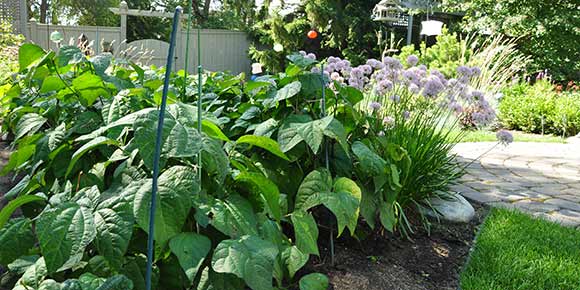Beans are an incredibly useful plant. They are full of protein – a quarter cup of any type of beans contains as much protein as an ounce of meat. A diet that contains regular portions of beans has been credited with lowering the risk of obesity, cancer, heart disease and diabetes.
Beans are a good source of soluble fibre, which helps trap cholesterol; according to some studies, eating a cup of beans a day can lower cholesterol by as much as 10% in just six weeks. One cup of raw green beans contains only25 calories.
And beans are delicious!
So why not grow your own? Although they are a warm weather crop -- they are very sensitive to frost -- over 2,000 varieties of beans can be grown in Canada, leaving you with lots of choices.
You can even grow some beans in containers, where you can control moisture and warmth and still harvest a worthwhile crop for a small space.
Basically, the beans we grow in kitchen gardens are either pole beans or bush beans. Pole beans are climbers, requiring support, but also producing heavy crops with the right treatment. Bush beans grow in bush form.
The beans most commonly grown in our kitchen gardens (botanical name: Phaseolus vulgaris) are green, string or snap beans (pretty much all the same thing, although the strings have now been bred out of a lot of varieties). These beans are grown for their immature pods, harvested when the pods are filled with beans, but before they swell, so they snap when you bend them. They are grown as both pole or bush varieties. Yellow or wax beans also belong in this category. French beans or ‘filet’ beans are snap beans grown for their flattened pods.
Some beans are grown for their immature seeds. These are called shell beans, and would include kidney, fava or broad beans, less commonly grown here.
Dry beans are grown for their mature seeds. These are the dry beans that need soaking and heavy cooking before use. Any type of bean can be grown for the dry product as long as it has about 100 days to mature.
Scarlet runner beans (Phaseolus coccineus) are often grown here only for their ornamental value, but when harvested at about five to nine inches, they are tender and delicious. When older they are a little tougher than our usual fare. The more mature shelled beans can be used as a substitute for lima beans.
The bush variety of Lima beans (Phaseolus lunatus), or butter beans, are earlier than the pole types and so are a good choice for the north. Typically grown for preserving, they should not be eaten raw as they contain linamarin, a cyanogenic glucoside: a handful of uncooked lima beans can make you seriously ill or even cause death. Cooking renders them nutritional and harmless and one cup of cooked lima beans contains 216 calories. Thorogreen bush lima bean is the earliest variety.
Beans should be harvested every couple of days once they get to the right degree of maturity for your needs. This will not only give you an ongoing fresh supply of the tasty treats, it will ensure a heavier crop.
Companion plants for beans: beets, cabbage, carrots, corn, cucumber, eggplant, lettuce, marigold, peas, radish, rosemary, savoury, squash and tansy.
Dorothy Dobbie is the publisher of Manitoba Gardener magazine. Call 204-940-2700 for a subscription or go to localgardner.net



